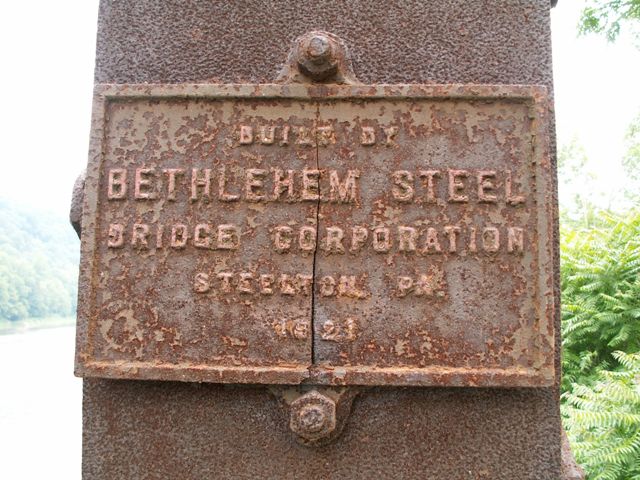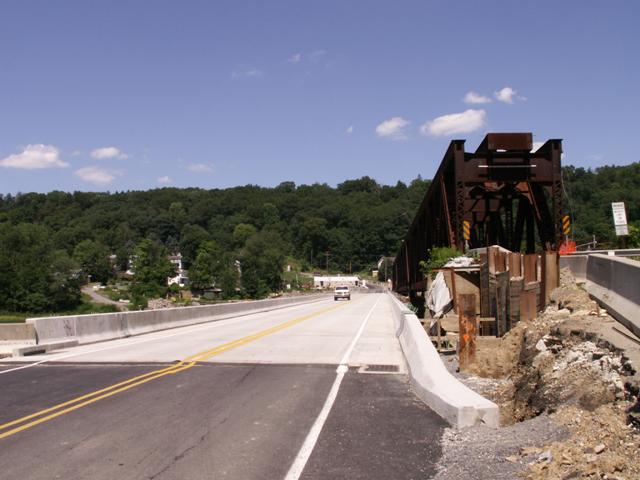We Recommend:
Bach Steel - Experts at historic truss bridge restoration.
BridgeHunter.com Phase 1 is released to the public! - Visit Now
Foxburg Bridge
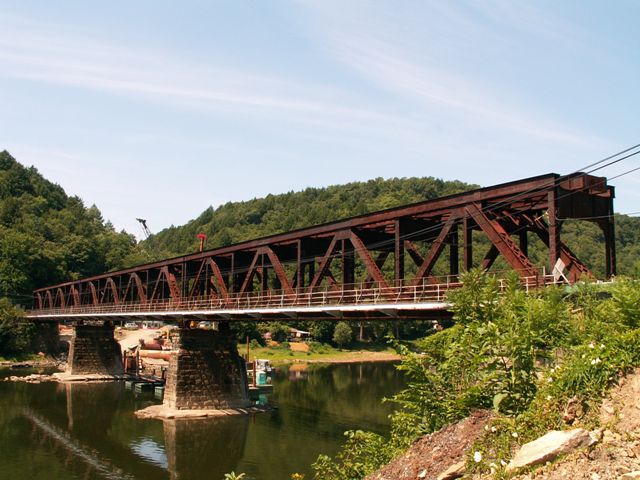
Primary Photographer(s): Nathan Holth and Rick McOmber
Bridge Documented: July 1, 2006
Foxburg: Armstrong County, Pennsylvania and Clarion County, Pennsylvania: United States
1921 By Builder/Contractor: Bethlehem Steel Bridge Corporation of Steelton, Pennsylvania
1985
174.0 Feet (53 Meters)
538.0 Feet (164 Meters)
14 Feet (4.27 Meters)
3 Main Span(s)
3005800200140

View Information About HSR Ratings
Bridge Documentation
This bridge no longer exists!
This bridge's song is:
View Archived National Bridge Inventory Report - Has Additional Details and Evaluation
This rare and unique historic bridge was demolished July 24, 2008 to make way for a replacement bridge's sidewalk!!!
View Two Historical Articles About The Construction of This Bridge
View An Archived Discussion of This Bridge From Disappearing Bridges, a Website That No Longer Exists
| Foreword: A Note From The Webmaster "The demolition of this bridge is one of the greatest atrocities against historic bridges and history in general to occur since urban renewal." Sadly, this sort of statement occurs several times on this website, often for bridges in Pennsylvania, but also for some bridges elsewhere. I worry that making this statement too often dilutes the meaning of the statement, and desensitizes people to the horrific fate that has befallen some of the finest bridges in the country. That is not my intention, and I hope that it does not desensitize you. The fact is that some of the finest bridges in the country are being destroyed, despite numerous opportunities for preservation. The Foxburg Bridge was one of the most unique bridges in Pennsylvania. As was the Ulster Bridge, and a few others in the state. To me, the demolition of these important historic bridges is nothing less than an atrocity. I do not know how else to describe it. I hope that as you view my pages, including this one, that you will understand I am not making these statements to dramatize bridges that are not worth saving. I have looked at the facts and combined those with my personal feelings as I stood before the portal of this bridge a week before its demolition. |
This bridge was a Warren through truss bridge with riveted connections. The presence of v-lacing on the verticals, and lattice on the diagonals added greatly to the intricate appearance of this bridge. A plaque of the bridge listed the builder as Bethlehem Steel Bridge Company. The date given was 1921. The bridge sat on ashlar abutments and piers. The bridge once carried trains on the top, with an approach system which had been demolished once leading trains to the upper deck of the structure. This unusual double-deck design made the Foxburg Bridge both historically significant and uniquely beautiful.
Engineers involved with the restoration and rehabilitation of historic bridges often argue over what function historic bridges should have as we move into the 21st Century. They question, often on a bridge-by-bridge basis, whether these narrow bridges, some of which were built before motor vehicles existed, can continue to support motorized traffic both safely and effectively. The answer to this question is not clear-cut, and it varies from bridge to bridge, based on design, condition, location, and needs. There is one common thread however. Time and time again however, one use for historic metal truss bridges appears to be one that many agree is an excellent way to use these bridges, especially when their continued use as vehicular crossings appears unfeasible: reuse either in place or a new location as a bridge carrying non-motorized traffic. This use is a great solution when the strength of the bridge and width of the bridge are not good enough for heavy and fast two-lane vehicular traffic.
The innovation of leaders in historic bridge preservation, such as Vern Mesler's restoration of the Charlotte Highway Bridge, have proved that bridges that exhibit large amounts of section loss on key structural elements can be restored, and do so within the financial constraints of the current grant programs that can be applied toward historic truss bridge restoration projects. The Charlotte Highway Bridge was in such poor condition that it had holes in its floorbeams. Today restored, the bridge today is expected to be good for the next 100 years.
Across the country, most notably in states other in Pennsylvania, where historic truss bridge preservation projects are actually taking place, there are numerous examples of truss bridges that are far older and of more lightweight in construction than a double-deck railroad bridge like the Foxburg Bridge have been restored for non-motorized traffic.
| Examples of Historic Truss Bridges Restored For Non-Motorized Traffic |
Note that this incomplete list of bridges featured on this website does not include another impressive list of similar bridges that were actually restored to continue to carry vehicular traffic, despite their age and design.
These are the facts that all existed when PennDOT decided to demolish the historic Foxburg Bridge. The example restorations above are largely lightweight highway truss bridges. The Foxburg Bridge was built in the 1930s as a much more massive and sturdy truss bridge that was designed to carry railroad traffic on one deck and vehicular traffic on another deck.
All of these facts suggest that the restoration of the Foxburg Bridge for non-motorized traffic would have been a feasible, affordable, and logical course of action.

Despite these facts, PennDOT built a new vehicular bridge next to the historic bridge. The historic Foxburg Bridge was then demolished to make way for the sidewalk on the modern bridge. In light of preservation examples elsewhere this is the most ridiculous waste of history and money imaginable. PennDOT has shown that it is completely unwilling to consider demolition, even in those cases where preservation is so logical and sensible. Prior to demolition, with the modern bridge standing right next to the historic bridge, the low profile of the new bridge not even blocking the view of the historic bridge, it would seem to someone from a pro-preservation state like Michigan or Texas to be an excellent example of a bypassed historic bridge where the historic bridge was serving the non-motorized component of the crossing. The scene simply screamed restoration for non-motorized traffic. Examples like the concrete Mottville Bridge support this thinking. But this is Pennsylvania. Why should a state with such beautiful rivers and hills be dotted by graceful works of historic engineering?
There was something about this bridge that people seemed to like. Even people who don't generally pay attention to bridges still seemed to see that this was a special bridge. Was it the unusual square shape? Was it the excellent tunnel effect if offers drivers? Was it the very impressive size of the massive members? Was it the fact that it once carried trains on top like a deck truss, while vehicles traveled beneath like a through truss? It is unclear, but a lot of people seemed to enjoy seeing this bridge. Except for PennDOT and the Foxburg town council. All of them have realized their dream of seeing this unique treasure wiped off of the face of the earth, and having a bland slab of concrete and steel for a bridge, forever marring the serene view of the beautiful river. How will the restaurant that overlooks the bridge in Foxburg advertise then? Come eat, while admiring the New Jersey Barriers of our bridge?! Not to be mean to Foxburg, but there is really not whole lot in the town to catch people's eyes and attract people over the river other than the bridge. The bridge should have been turned into the highlight of Foxburg. Even as it stood prior to demolition, the bridge was the highlight of Foxburg. Even people who live in Pennsylvania and are used to seeing truss bridges might have picked this bridge out as an unusual one.
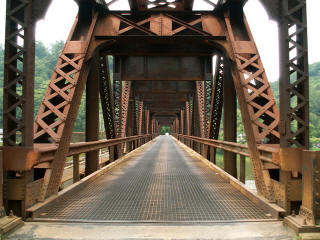
It remains a mystery as to why the Foxburg Council supported the demolition of this historic bridge, yet personally requested that PennDOT save the bridge's builder plaque and some stones from the bridge for display at a future city facility. Another interesting fact. The demolition of the bridge used explosives, allowing PennDOT to evacuate people within a 1250 feet radius around the bridge, as a safety measure. Also, conveniently for PennDOT, this makes viewing the actual demolition nearly impossible. Perhaps they made a point of using explosives, so that they could attempt to hide this atrocity from the public as much as possible.
The replacement of this bridge is yet another example of how Pennsylvania has one of the poorest track records for bridge preservation in the country. PennDOT has, over the past few years, literally been obliterating the Allegheny River. The Allegheny River once had some of the finest and most unusual historic bridges ever seen on it, and one by one, PennDOT is demolishing each one. Indeed, there is not a single example of a genuine commitment to historic bridge preservation on the Allegheny River in Pennsylvania, between the city limits of Pittsburgh and the river's source, which is near the state of New York. The Foxburg bridge was a bridge that was truly unique, and for this reason it had a very high degree of historic significance. In a world where transportation policy and historic preservation policy functioned in a feasible and sensible manner, the Foxburg Bridge would have been preserved.
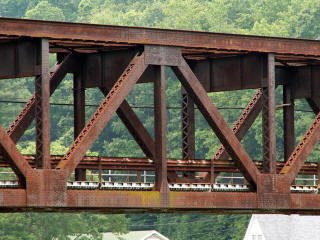
The new bridge standing alone is the ugliest thing one could imagine. Both Foxburg and PennDOT have thrown away a treasure, and they have done so when opportunities for preservation presented themselves at every step along the way. Pennsylvania is truly a failure when it comes to historic bridge preservation. Even if PennDOT and friends change their ways, it may be too late. Pennsylvania's bridges, especially the rarest and most unique ones, are those falling the fastest.
Historic significance is a cold phrase to describe the Foxburg Bridge... this bridge was a beautiful work of art carried with it the essence of the people who built it. Not so much from the engineers, but from the actual people who sweated in the steel mills to fabricate the metal, the riveters who assembled the beams of the bridge together, and the people who erected the bridge over the river. The people who built the historic Foxburg Bridge put a lot more into this bridge than people today. With no disrespect intended toward workers today, but bridge construction is not the same thing today, where sit in air conditioned cranes or cement trucks while building a bridge, all the while protected by OSHA regulations. Vern Mesler, a leading expert on historic bridge restorations, often calls truss bridges a "craftsman's record." In many ways these bridges are even more than that... they are the essence of those craftsman. We all like to believe that we do some good in the world, and that we leave something behind in the world for people to enjoy and remember them by. For those craftsmen, that's what these bridges are. More than just a bridge, this is what PennDOT has taken away from us..
Foxburg's unique landmark is gone forever, and nothing can ever bring it back.
![]()
Photo Galleries and Videos: Foxburg Bridge
Structure Overview
Original / Full Size PhotosA collection of overview photos that show the bridge as a whole and general areas of the bridge. This gallery offers photos in the highest available resolution and file size in a touch-friendly popup viewer.
Alternatively, Browse Without Using Viewer
![]()
Structure Details
Original / Full Size PhotosA collection of detail photos that document the parts, construction, and condition of the bridge. This gallery offers photos in the highest available resolution and file size in a touch-friendly popup viewer.
Alternatively, Browse Without Using Viewer
![]()
Structure Overview
Mobile Optimized PhotosA collection of overview photos that show the bridge as a whole and general areas of the bridge. This gallery features data-friendly, fast-loading photos in a touch-friendly popup viewer.
Alternatively, Browse Without Using Viewer
![]()
Structure Details
Mobile Optimized PhotosA collection of detail photos that document the parts, construction, and condition of the bridge. This gallery features data-friendly, fast-loading photos in a touch-friendly popup viewer.
Alternatively, Browse Without Using Viewer
![]()
Bridge Demolition
These photos document what was nothing less than an atrocity; the removal of a historic bridge to make way for a non-motorized sidewalk. Also has photos of the bridge just before demolition, showing how the two bridges fit beside each other. This photo gallery contains a combination of Original Size photos and Mobile Optimized photos in a touch-friendly popup viewer.Alternatively, Browse Without Using Viewer
![]()
Bridge Demolition
Full Motion VideoMotion picture showing the demolition including implosion and site walkthough. Source: Pennsylvania Department of Transportation. Streaming video of the bridge. Also includes a higher quality downloadable video for greater clarity or offline viewing.
![]()
Maps and Links: Foxburg Bridge
This historic bridge has been demolished. This map is shown for reference purposes only.
Coordinates (Latitude, Longitude):
Search For Additional Bridge Listings:
Bridgehunter.com: View listed bridges within 0.5 miles (0.8 kilometers) of this bridge.
Bridgehunter.com: View listed bridges within 10 miles (16 kilometers) of this bridge.
Additional Maps:
Google Streetview (If Available)
GeoHack (Additional Links and Coordinates)
Apple Maps (Via DuckDuckGo Search)
Apple Maps (Apple devices only)
Android: Open Location In Your Map or GPS App
Flickr Gallery (Find Nearby Photos)
Wikimedia Commons (Find Nearby Photos)
Directions Via Sygic For Android
Directions Via Sygic For iOS and Android Dolphin Browser
USGS National Map (United States Only)
Historical USGS Topo Maps (United States Only)
Historic Aerials (United States Only)
CalTopo Maps (United States Only)




